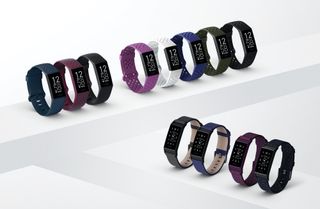
If you're looking for a lightweight fitness tracker, the Fitbit Charge 3 and Fitbit Charge 4 are well worth adding to your shortlist. But which one should you pick? We're here to explain all the key differences so you can make the right choice
The Fitbit Charge 3 was released in 2019 and the Charge 4 in 2020, and the two look almost identical. The biggest difference is that the Charge 4 has on-board GPS, which means you can track outdoor activities like walks, runs and bike rides without the need to carry a phone. If you're into outdoor cardio then the Charge 4 is likely to have the edge.
There may soon be another option to consider as well. Nothing has been confirmed yet, but a recently leaked image suggests that a new slimline Fitbit may soon be announced, and it could well be the Fitbit Charge 5. Details of the watch (codenamed Morgan) are scant so far, and Fitbit hasn't given any comment, but it appears to have a similar overall shape to previous models, with a new color screen.
We'll keep you updated as soon as we know more, but for now, here's everything you need to know about the Charge 3 and 4.
Price
- Both devices were same price at launch
- Charge 3 is typically cheaper in Australia
- Charge 4 is usually cheaper in US and UK
The Fitbit Charge 3 and Fitbit Charge 4 were released at the same price ($149.95 / £129.99 / AU$229.9), but both devices are now available significantly cheaper.
Interestingly, prices for the two devices now vary greatly depending on where you live. If you live in the US, the older Charge 3 is slightly cheaper, costing about $100. The Charge 4 can be found for around $120.
In the UK, the Charge 3 is usually the more expensive, costing about £120 compared to around £100 for the newer Charge 4. This seems to be due to almost constant special offers on the Charge 4, which result in retailers matching each other's prices.
Get daily insight, inspiration and deals in your inbox
Get the hottest deals available in your inbox plus news, reviews, opinion, analysis and more from the TechRadar team.
The same is true in Australia, where the Charge 3 costs about AU$190, and the Charge 4 usually retails at around AU$180.
These prices are subject to fluctuations though, so we've rounded up the best offers near you right here:
Design
- Same basic design
- Charge 3 case is stainless steel, while Charge 4 is resin
- Special Edition models have different colors and bands
As previously mentioned the Charge 3 and Charge 4 look almost identical, with the same slim rectangular case and neat strap.
The Fitbit Charge 3 has a case made from aluminum, whereas the Charge 4's is made from plastic resin. The Charge 3's case measures 35.8 x 22.7 x 11.8mm and weighs 29g, while the Charge 4's is 28.8 x 42.7 x 12.5mm and weighs 30g (likely due to the added GPS receiver).
Both devices have an inductive button on the left-hand edge, which you can use to wake the 1-inch grayscale OLED touchscreen, or send it to sleep.
When it comes to colors, the standard Fitbit Charge 3 is available with a black silicone band and graphite case, or a blue-gray silicone band and rose gold case. The Special Edition Fitbit Charge 3 is available with a woven purple band and rose gold case, or a colored perforated silicone sport band and a graphite case.
The standard Fitbit Charge 4 is available in black, Rosewood (a dark purple) and Storm Blue. All three have a silicone band. The Charge 4 Special Edition comes with a black case and Granite (dark gray reflective) woven band. It's also supplied with a silicone band if you'd like to swap it.

Battery life
- Both last seven days in normal use
Fitbit estimates that both the Charge 3 and Charge 4 will keep running for seven days between charges, and our tests bear that out. The Fitbit Charge 4 will last around five hours with continuous GPS use.
Smartwatch features
- Only Fitbit Charge 4 provides Spotify controls
- Contactless payments with Fitbit Charge 3 Special Edition and Charge 4
Both the Charge 3 and Charge 4 will alert you to incoming texts and calls, and provide alerts from third-party apps on your phone.
The Fitbit Charge 4 allows you to control your Spotify playlist, provided your phone is nearby and you have a Spotify Premium subscription. There's no such feature available for the Charge 4.
Provided your bank is among those supported, the Fitbit Charge 4 allows you to make contactless payments via Fitbit Pay. The standard Fitbit Charge 3 is equipped with Fitbit Pay for users in Australia, but if you live in the US or UK, it's only available on the Charge 3 Special Edition.

Fitness features
- Fitbit Charge 4 has full on-board GPS
- Both offer automatic workout detection
- Both have heart-rate monitoring and SpO2 sensor
As mentioned previously, the key difference between the Fitbit Charge 3 and Fitbit Charge 4 when it comes to fitness features is the newer device's on-board GPS. You can still track outdoor activities with the Charge 3, but only if it's connected to your phone via Bluetooth. With the Charge 4, you can leave your phone at home and still see your runs mapped out afterwards in the Fitbit app. You can sync this data with third-party apps like Strava.
Both watches can automatically detect when you start a workout and begin monitoring the time and your heart rate, but the Fitbit Charge 4's on-board GPS must be started manually (presumably to prevent it draining the battery when you're out and about running everyday errands).
The Charge 3 and Charge 4 both have a mindfulness app that will lead you through a deep breathing exercise if you feel stressed.
Both devices provide sleep tracking, and will estimate levels of light, deep and REM sleep, which you can see in the mobile app in the morning.
Both also have an SpO2 sensor for monitoring blood oxygen saturation as you sleep. Some variations in saturation are normal, but significant dips can be a sign that you're suffering from sleep apnea, which is a condition where you stop breathing for brief periods overnight. The Fitbit app will alert you if such a problem is detected, and suggest that you talk about the results with your doctor.
Neither device is capable of taking an ECG - for that you'll need the higher-end Fitbit Sense.

Conclusion
- Fitbit Charge 4 is our recommended device
The Fitbit Charge 3 and Charge 4 are both excellent fitness trackers, but considering the extra features and similar (or even lower) price, we'd recommend opting for the Charge 4. Even if you don't use its on-board GPS frequently, it's always good to have the option, and tools like contactless payments as standard make it our top choice.
If these devices are too expensive, there are lots of more affordable watches listed in our guide to the best cheap fitness trackers. Alternatively, if you're a serious runner and want more advanced training tools, take a look at our roundup of the best running watches.
- Check out our complete guide to the best Fitbits
Cat is the editor of TechRadar's sister site Advnture. She’s a UK Athletics qualified run leader, and in her spare time enjoys nothing more than lacing up her shoes and hitting the roads and trails (the muddier, the better)

